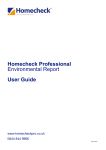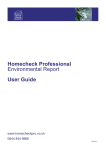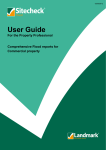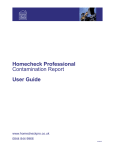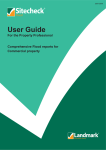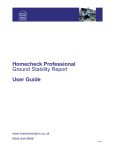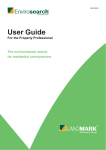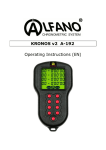Download Homecheck Professional® User Guide
Transcript
Homecheck Professional® Flood Report User Guide www.homecheckpro.co.uk 0844 844 9966 18/09/2012 User Guide Table of Contents Introduction - About this Guide 2 Why should I get a Homecheck Professional Flood Report? 2 How do I get a Homecheck Professional Flood Report? 2 What is my Homecheck Professional Flood Report telling me? 3 Appendix Appendix 1: Data sets used in the Homecheck Professional Flood Report 10 Appendix 2: The Search Code 13 1 1. Introduction – About this Guide 1.1 This Guide has been prepared by Landmark Information Group to assist busy conveyancing practitioners to decide: • Whether to obtain a Homecheck Professional Flood Report on behalf of their clients. • What that search reveals. 2. How do I get a Homecheck Professional Flood Report? 2.1 A Homecheck Professional Flood Report can be ordered by using one of our order forms or alternatively via our website at www.homecheckpro.co.uk. To obtain an order form or register for an account to order online please contact: Landmark Information Group Limited Legal & Financial Imperium Imperial Way, Reading Berkshire RG2 0TD Telephone: 0844 844 9966 Fax: 0844 844 9980 DX: 154400 Henley-on-Thames 2 E-mail:[email protected] Internet: www.homecheckpro.co.uk 2.2 A separate search should be made for each individual property having a different postal address. 2.3 Order forms should be completed by including: 2.4 • The full postal address and postcode of the property. • The name and Document Exchange (DX) number (if applicable) of the practitioner. • The practitioner's file reference and telephone number. • A plan of the property (see paragraph 2.4 below). If you are using an order form it is requested that a plan showing the location of the property is enclosed with your order. If a plan is not supplied there may be difficulties in identifying the location of the property and this may introduce a delay. 2 2.5 In normal circumstances a Homecheck Professional Flood Report will be despatched to the practitioner within 24 to 48 hours of the receipt of the order. 2.6 The Homecheck Professional Flood Report is also available electronically, normally within 24 hours. 3. What is my Homecheck Professional Flood Report telling me? 3.1The Homecheck Professional Flood report is a desktop flood risk screening report, designed to enable property professionals to assess the risk of flooding at residential sites. It examines two key areas; the overall risk of flooding at a site taking into account any flood defences present (where these are identified) and how flood risk affects the availability of insurance for a site. The report considers current Government guidance including the National Planning Policy Framework (NPPF) and the current agreement between insurance companies and central Government. The report has been designed and produced by qualified flood risk specialists using the data available in this report. 3.2 The report will include information from a number of statutory and non-statutory sources, and also provides guidance on the presence of features that could create a flood risk. 3.3 Landmark has agreements for the supply or collection of data with a number of national data providers. Notably, Landmark is a Licensed Partner of Ordnance Survey and a Value Added Reseller for the Environment Agency and the British Geological Survey. The currency of the datasets used is determined by the frequency of updates by the data providers under their respective agreements with Landmark. 3.4 Any person relying on a Homecheck Professional Flood Report must comply with the attached Terms and Conditions. 3.5 The replies in the Homecheck Professional Flood Report will be given in the belief that they accord with the data sets and update cycles listed in Appendix 1, but on the understanding that Landmark is not legally responsible for them except as detailed in the Terms and Conditions, which may vary from time to time. 3.6 Landmark is constantly working with data providers to improve the data sets and the information available to Landmark may change. Accordingly, there is no protection period relating to a Homecheck Professional Flood Report and practitioners should not attempt to rely on a previous report. Practitioners who rely on a previous report will not have the benefit of Landmark's Professional Indemnity Insurance cover. 3.7 Practitioners should note that addresses may have been compared to the Royal Mail Postal Address File standard and therefore may have been changed to comply with this standard. 3.8 The report is split into sections, which presents the information in an easy to understand question and answer format. 3.9 The practitioner should normally be able to easily verify that the report has been correctly located on the subject property using the Site Location map. In the event of any doubt as to the correct location the practitioner should raise this immediately with our helpdesk or the agent or reseller. 3.10 The Homecheck Professional Flood Report uses the boundary of the property as the basis of the. Alternatively, the search can be ordered as a point location and our system will construct a 25m radius circle around this point which will be used as the property boundary for the purposes of the report. Please note that use of the 25m circle is not an attempt to make an approximation of the property boundary. 3 Professional Opinion 3.11 The Homecheck Professional Flood report includes a Professional Opinion on the front page which will indicate whether, based on the data revealed in the report, there is any flood risk associated with the property. The replies are colour coded green and red. Green indicates a "PASSED" assessment. When a lower level of flood risk has been identified, one of the following statements will be shown: Negligible Risk: The overall flood risk rating for the Site is assessed to be 'Negligible'. No further action is considered necessary, however a prudent purchaser may wish to consider the prudent measures outlined on page 2. Low Risk: The overall flood risk rating for the Site is assessed to be 'Low'. No further action is considered necessary, however a prudent purchaser may wish to consider the prudent measures outlined on page 2. Moderate Risk: The overall flood risk rating for the Site has been assessed as being 'Moderate'. This means that existing datasets reveal the site is in an area which is susceptible to flooding. A prudent purchaser may wish to consider further assessment in order to clarify the risk of flooding or the installation of flood protection measures. We would draw your attention to the recommendations on page 2. Red indicates that FURTHER ACTION is required as a result of an elevated flood risk being identified. The following statement will be shown: High Risk: The overall flood risk rating for the Site has been assessed as being 'High'. This means that existing datasets reveal significant flood risk issues which should be addressed. Further assessment is recommended in order to clarify the risk of flooding at the Site and to determine appropriate flood protection measures. We would draw your attention to the recommendations on page 2. Overall Flood Risk and Flood Gauges 3.12 An overall flood risk rating is provided on the front page, based on an assessment of the data provided within the report. The overall risk rating in the report takes into account the effect of flood defences, where these are identified, based on the presence of flood defences registered by the Environment Agency within the vicinity of the Site. It should be noted that a residual risk of flooding may remain if such defences were to fail owing to extreme weather conditions, over-topping or poor maintenance. In addition, it should be noted that flood defences do not generally offer protection against groundwater or surface water flooding. Where no flood defences are present in the vicinity of the Site the overall risk rating provides a worst case scenario which may be alleviated by smaller scale local flood defences or recently constructed flood defences not currently registered by the Environment Agency. Replies in Scotland will always present the worst case scenario where there are no flood defences in the area benefiting the site or assuming any flood defences will fail or be over-topped. This is because data regarding flood defences in Scotland is currently unavailable from the Scottish Environmental Protection Agency and Local Lead Flood Authorities. The overall risk of flooding will be answered by one of four standard responses: 4 Risk Level Meaning Negligible The data does not indicate any risk at the property itself, or any feature within the locality of the property, which would be expected to pose a threat of flooding. Argyll does not consider it necessary to make any further investigations into flood risk. Low The data suggests that the overall risk to the property is low and Argyll does not consider it necessary to make any further investigations into flood risk. If the property is large (over 1 ha) it would require a Drainage Impact Assessment to accompany any planning application. Moderate The data indicates that overall flood risk to the property is moderate. Argyll would normally suggest that further investigations to clarify the risk of flooding would be prudent. High Here the data indicates that the overall flood risk to the property is assessed as high, with a consequent risk to life and property. The flood risk issues will need to be addressed. Further assessment is recommended in order to clarify the risk of flooding at the property. 3.13 When a property has been assessed as having a negligible, low or moderate flood risk rating the green (PASSED) colour coding will apply. Where a property has been assessed as having a high flood risk rating the red (FURTHER ACTION) colour coding will apply. In these cases detailed recommendations can be found on the second page of the report followed by further information and cost estimates for flood resilience measures. Further guidance can also be obtained by calling Landmark customer services on 0844 844 9966. 3.14 The flood risk gauges provide a more detailed analysis of the risk from each of the four main types of flooding – river, coastal, groundwater and surface water. In addition, a fifth gauge provides an analysis of other factors (i.e. historic flood events) that may affect the overall flood risk. For undefended fluvial and tidal flood risk and surface water flood risk data provided by JBA, only the risk rating generated during the modelled 1:200 year return event is considered in the overall risk assessment. The data on 1:75 year and 1:1,000 year return events are provided for information only. This analysis takes into account any existing flood defences, where these are identified, that are intended to protect the Site and assumes that these work as designed. The analysis also takes into account the other information contained in those data sections of the report which are relevant to that particular type of flooding. The assessment of the risk as shown in the flood gauges should therefore take priority over the information in the individual data sections of the report. Types of flood risk 3.15 The flood risk has been assessed by looking at the four main types of flooding. The risk from each type of flooding will be displayed as a flood gauge beneath the overall risk rating. These main types of flooding are: 5 Flood Type Description River/Fluvial River flooding mainly happens when the river catchment (that is the area of land that feeds water into the river and the streams that flow into the main river) receives greater than usual amounts of water (for example through rainfall or melting snow). The extra water causes the level of the water in the river to rise above its banks or retaining structures. This flooding may take place at any point along the river course and not necessarily at the place where the extra water has entered. In upland rivers, the flooding is usually temporary but more prolonged flooding can occur in lowland rivers, where the gradient is much flatter, possibly only a few inches per mile. There, downstream flooding can prevent drainage of areas upstream, leading to ponding of the water discharging from higher up the catchment in the flood plain. Coastal/Tidal Coastal flooding is caused by the inundation of land areas along the coast due to sea water rising above normal tidal conditions. Coastal flooding can arise from a combination of high tides, wind induced tidal surge, storm surge created by low pressure and wave action. There is also the likelihood of a general rise in sea level caused by climate change. Pluvial Pluvial or surface water flooding results from rainfall running over ground before entering a watercourse or sewer. It is usually associated with high intensity rainfall (typically greater than 30mm per hour) but can also occur with lower intensity rainfall or melting snow where the ground is already saturated, frozen, developed (for example in an urban setting) or otherwise has low permeability. This type of flooding results in overland flow and ponding in depressions in the topography. Groundwater Ground water flooding occurs when ground water levels increase sufficiently for the water table to intersect the ground surface. Ground water flooding can occur in a variety of geological settings including valleys in areas underlain by chalk, and in river valleys with thick deposits of alluvium and river gravels. Contributing factors include a combination of already high ground water levels (usually during mid or late-winter) and intense or unusually lengthy rainfall periods. Ground water flooding may last for weeks or months often much longer than flooding caused by a river or coastal sources. Insurability 3.16 We provide an assessment of whether buildings and contents insurance are likely to be available at standard terms. Replies in England and Wales are based on the consideration of NaFRA data supplied by the Environment Agency and surface water (flash) flooding data supplied by JBA Risk Management Ltd.. Replies in Scotland are based on the consideration of the river flood (undefended fluvial) data and surface water flooding data supplied by JBA Consulting. This data is used by insurance companies to determine the suitability of a property for insurance, although they may access additional information which could affect their assessment. Under the Association of British Insurers’ Revised Statement of Principles on the Provision of flooding Insurance (July 2008), the general policy of member companies is that flood insurance for domestic properties and small businesses should continue to be available for as many customers as possible until 1st July 2013, by which time a longer term solution should be implemented. The premiums charged and other terms will reflect the risk of flooding but insurance will be available: 1. For properties where the flood risk is not significant (generally defined as no worse than 1.33% or 1–in-75 years annual probability of flooding); and 2. To existing domestic property and small business customers at significant risk, providing the Environment Agency has announced plans to reduce that risk within five years, such as improving flood defences. (The commitment to offer cover will extend to the new owner of any applicable property subject to satisfactory information about the new owner). 6 However, for significant risk areas where no improvements in flood defences are planned, and in all cases other than domestic properties and small businesses, insurers cannot guarantee to provide cover, but will examine the risks on a case-by-case basis. The implementation of the revised Statement of Principles depends on action from the Government and is continually reviewed by insurers. In addition, the revised Statement of Principles does not apply to properties built after 1st January 2009. Different guidance applies to these (see Climate Change – Guidance on Insurance Issues for New Developments from www.abi.org.uk). The responses to the question ‘Is the property likely to be insurable at standard terms?’ assume the property is an existing domestic property and makes no allowance for previous claims arising from any type of flooding, nor for non-flood related risks such as subsidence. If the response to the question is “YES”, the property is likely to be considered acceptable by insurance companies at standard terms and flood insurance should not be difficult to obtain. If the response to the question is “NO”, the property is not likely to be considered acceptable by insurance companies at standard terms, on the basis of current information. Further work may be required in order to obtain acceptable insurance terms for flood risk. This could include a more detailed risk assessment or the use of accredited products, flood resilience materials and temporary defences to defend the property. Enquiries and Replies 3.17 The Homecheck Professional Flood Report will be based on the information listed in Appendix 1 to this Guide. The practitioners’ attention is drawn to the update cycles for this information. 3.18 Section A of the report will include information relating to river, coastal and surface water flood risk from JBA Risk Management Ltd. The section is divided into three sub-sections as follows: • Section A1 with show a map with subsequent supporting data regarding potential flood depths from a 1 in 75 year flood event; • Section A2 with show a map with subsequent supporting data regarding potential flood depths from a 1 in 200 year flood event; • Section A3 with show a map with subsequent supporting data regarding potential flood depths from a 1 in 1000 year flood event. 3.19 Section B of the report will include information from the Environment Agency regarding river/coastal flooding at the property. The report identifies if the property is: • In or within 250 metres of an area affected by flooding (Zone 3) or extreme flooding (Zone 2). • In or within 250 metres of flood defences recorded by the Environment Agency. • In or within 250 metres of an area recorded by the Environment Agency as benefitting from flood defences. This data is plotted on a single map that follows the detailed supporting data. This section of the report will also provide data relating to NaFRA (National Flood Risk Assessment) from the Environment Agency. The Environment Agency has used its own data to make an assessment of the risk of river or coastal flooding to the areas of land within Flood Zones 2 and 3. It was originally invented as a guide to where flood defences were most needed. The risk assessment takes into account a variety of hypothetical levels of rainfall or coastal flooding (both in terms of intensity and duration) and any flood defences that are in place, which it assumes will work effectively. It looks at the data for grid squares that are 50m2 in extent and assigns a risk level (either low, moderate or significant) for the whole square. It cannot differentiate between properties within the grid square (perhaps on grounds of relative height). Nor does it predict the depth of resultant flooding (merely the risk of flooding occurring at all). NaFRA data does not include flood risk from very small catchments as models of such small scale catchments are not considered to be reliable for UK-wide flood risk assessments. The potential impact of climate change on flood risk to the property would require further study. 7 The assessment is regularly updated by the Environment Agency and Argyll use the latest version supplied by NaFRA. Many insurers use NaFRA as a guide to where to offer flood risk insurance cover. Please refer to Appendix 1 to this guide and to the footnotes in section A of the report itself for detailed information on the data used in this section. 3.20 Section C of the report will include information from the British Geological Survey (BGS). The BGS Susceptibility to Groundwater flooding hazard dataset identifies where geological conditions could enable groundwater to come close to the surface and cause groundwater flooding. The susceptibility data is suitable for use for regional or national planning purposes where the groundwater flooding information will be used along with a range of other relevant information to inform land-use planning decisions. BGS advise that the data should not be used to assess the precise risk at any particular property. Susceptibility to groundwater flooding will report the worst case within the search area and the responses are: • No Data • Very Low • Low • Moderate • High • Very High It is a hazard dataset not a risk dataset, in that it records where the conditions are suitable for ground water flooding but not how often it might occur or has occurred (i.e a high susceptibility does not necessarily mean that the property is at high risk of groundwater flooding.) Please refer to Appendix 1 to this guide and to the footnotes in section C of the report itself for detailed information on the data used in this section. 3.21 Section D of the report will include information relating to historical flooding using data from the Environment Agency. The report identifies if the property is: • In or within 250 metres of an area affected by an Historical Flood Event It should be noted that the EA’s historical flood event database is not comprehensive. Furthermore, details regarding the nature of any historical flood events identified are not supplied in this report. Further information can be obtained by contacting your local Environment Agency office. Furthermore, Section D of the report will supply information relating to Flood Insurance Claims using data provided by Crawfords (Crawford and Company Flood and Theft Postcode Sector Insurance Claim Ratings). An insurance claims rating for flood risk is derived from the number of flood insurance claims in the postcode sector. Data is gathered from a large number of insurance companies and includes validated claims notified to insurers including river and coastal flood, heavy rainfall and flooding following blockages to sewers etc. They do not include an escape of water from a fixed appliance. The insurance claim rating responses are: • High • Medium • Low • Very Low • No Data Available 8 “High” is usually (but not invariably) associated with river or coastal flood. It is usually indicative of groups of claims with several properties suffering damage as the result of a specific event. This would indicate a sector with more than 5 claims per 1000 households. “Medium” is usually indicative of groups of houses, not necessarily over a wide area, that have suffered damage as a result of heavy rainfall, over-topping of the rainwater system or their location being on low lying ground. This would indicate a sector with between 2 and 5 claims per 1000 households. “Low” suggests individual claims associated with failure of underground drainage systems or possibly localised events like flooding of the roadway following heavy rainfall. This would indicate a sector with less than 2 claims per 1000 households. "Very Low" indicates there are no recorded claims. "No Data Available" means there are insufficient properties in the postcode sector to make a meaningful assessment. Please refer to Appendix 1 to this guide and to the footnotes to section D in the report itself for detailed information on the data used in this section. 4. Limitations of the Report The Homecheck Professional Flood report has been designed to satisfy basic flood-related environmental due-diligence enquiries for residential properties. It is a desktop review of information provided by the client and from selected private and public databases. It does not include a site investigation, nor are specific information requests made of the regulatory authorities for any relevant information. Therefore, Landmark cannot guarantee that all issues of concern will be identified by this report, or that the data and information supplied to it by third parties is accurate and complete. The assessment within the report has been undertaken on a point location provided by the client and a 25m buffer placed around that point in order to assess the most likely areas associated with the property of interest. Landmark cannot be responsible for incidents where the 25m buffer does not encompass the entirety of the property demise. This report includes an assessment of surface water flooding which examines the risk of the general drainage network overflowing during periods of extreme rainfall. This report does not make a detailed site-specific assessment of the suitability of the existing drainage on the Site. If this is required, then a site survey should be considered. The assessment of pluvial flooding does not take into account particular local or temporary factors that may cause surface water flooding such as the blockage or failure of structures on or within watercourses, drains, foul sewers, water mains, canals and other water infrastructure; and any history of drains flooding at the Site or in the locality. Surface water flooding can occur before surface water reaches the general drainage network, for example on hills and inclines. Environment Agency and JBA fluvial and coastal flood data does not include flood risk from very small catchments as models of such small scale catchments are not considered to be reliable for UK-wide flood risk assessments. The potential impact of climate change on flood risk to the Site would require further study. Replies in Scotland are based on the best available data in that locality. The overall risk assessment and insurability assessment will still provide a response based on the best available information within this report. Where information is unavailable or has not been provided for a region the relevant data section will report No Data. When answering any questions within this report, current applicable legislation is taken into account. The data used in this report may have inherent limitations and qualifications. Further details are set out in Appendix 1. 9 Appendix 1: Data Sets Used in the Homecheck Professional Flood Report Title Remarks Source Data Type Data Range Update Cycle Section Areas Benefiting from Flood Defences This data set shows those areas benefiting from demarcated flood defences whereby in a 1% fluvial or 0.5% tidal flood event, areas that would otherwise flood are protected, provided that the defences do not breach. Environment Agency Polygon & Text From 2005 Quarterly B BGS Groundwater Flooding Susceptibility This data set is the first national hazard or susceptibility data set of groundwater flooding. Groundwater flooding is increasingly recognised as a hazard and can be defined as the emergence of groundwater at the ground surface, or the rising of groundwater into manmade ground under conditions where the normal range of groundwater levels is exceeded. Based on geological and hydrogeological information, digital data has been used to identify areas where geological conditions could enable groundwater flooding to occur and where groundwater may come close to the ground surface. The data set defines areas with one of five levels of groundwater susceptibility, ranging from high susceptibility to negligible or no susceptibility. Areas with no data represent areas with no susceptibility to groundwater flooding. The resolution of the modelled output is 50m by 50m cells. The data set is a hazard data set, not a risk data set, meaning that it does not provide any information about the likelihood of a groundwater flooding event occurring. British Geological Survey (BGS) Polygon & Text Not Applicable Annual C Extreme Flooding from Rivers or Sea without Defences (Zone 2) Flood Zones are defined by the Government’s Planning Policy Statement 25 on ‘Development and Flood Risk’ for England (PPS25) dated December 2006, which replaces Planning Policy Guidance 25: Development and Flood Risk (PPG25), published in July 2001. The Flood Zones are defined in table D.1 of PPS25 and illustrate the probability of flooding across England for planning consultation and have been identified using the best available data held by the Environment Agency ignoring the presence of flood defences. This data set is Flood Zone 2 (Medium Probability), which comprises areas of land assessed as having between a 1 in 100 and 1 in 1000 annual probability of river flooding (1% – 0.1%) or between a 1 in 200 and 1 in 1000 annual probability of sea flooding (0.5% – 0.1%) in any year. This definition of Flood Zone 2 applies only in England. Equivalent data is also provided for Wales, although in Wales the data does not have the same relationship to Planning Policy and is not referred to as Flood Zones. Environment Agency Polygon & Text From 2005 Quarterly B Flood Defences This is the Environment Agency’s holding of Linear Flood Defences. This data set contains all flood defences constructed during the last five years with a standard of protection equal to or better than 1% for rivers and 0.5% from the sea. Some additional defences, which may be older or may have been designed to provide a lower standard of protection, are also shown where the information is currently available. This layer comprises linear flood defences, for example flood embankments and walls. Environment Agency Polygon & Text From 2005 Quarterly B 10 Appendix 1: Data Sets Used in the Homecheck Professional Flood Report Title Remarks Source Data Type Data Range Update Cycle Section Flooding from Rivers or Sea without Defences (Zone 3) Flood Zones are defined by the Government’s Planning Policy Statement 25 on ‘Development and Flood Risk’ for England (PPS25) dated December 2006, which replaces Planning Policy Guidance 25: Development and Flood Risk (PPG25), published in July 2001. The Flood Zones are defined in table D.1 of PPS25 and illustrate the probability of flooding across England for planning consultation and have been identified using the best available data held by the Environment Agency ignoring the presence of flood defences. This data set combines Flood Zone 3a (High Probability) and Flood Zone 3b (The Functional Floodplain). Flood Zone 3a comprises land assessed as having a 1 in 100 or greater annual probability of river flooding (>1%) or a 1 in 200 or greater annual probability of flooding from the sea (>0.5%) in any year. Flood Zone 3b comprises land where water has to flow or be stored in times of flood. Strategic Flood Risk Assessments (SFRAs) should identify this Flood Zone (land which would flood with an annual probability of 1 in 20 (5%) or greater in any year or is designed to flood in an extreme (0.1%) flood, or at another probability to be agreed between the LPA and the Environment Agency, including water conveyance routes). These definitions of Flood Zone 3a and 3b apply only in England. Equivalent data is also provided for Wales, although in Wales the data does not have the same relationship to Planning Policy and is not referred to as Flood Zones. Environment Agency Polygon & Text From 2005 Quarterly B Flood Water Storage Areas The Environment Agency’s holding of ‘Flood Storage Areas’. A flood storage area may be referred to as a balancing reservoir, storage basin or balancing pond. Its purpose is to attenuate an incoming flood peak to a flow level that can be accepted by the downstream channel. It may also delay the timing of a flood peak so that its volume is discharged over a longer time interval. Environment Agency Polygon & Text From 2005 Quarterly B Historic Flood Map (Historic Flood Extents) This dataset shows the combined extents of known flooding from rivers, the sea and groundwater where records exist Environment Agency Polygon 1947 present Quarterly D JBA Fluvial Flood Risk 75, 200 and 1000 Year Return periods This dataset describes the fluvial flood hazard for 75, 200 and 1000 year return periods for England, Wales and most of Scotland. Fluvial flooding occurs when rivers overflow and burst their banks, due to high or intense rainfall which flows into them. A return period is the statistical probability of the flood happening in any given year. i.e. a 75 year return period is a 1 in 75 chance. This dataset is produced using Jeremy Benn Associates Ltd. In-house software, JFlow. This is a 2D hydraulic model that is designed specifically to meet the needs of broad-scale modelling. This dataset does not take flood defences into account. Jeremy Benn Associates Ltd. Polygon & Text Not Applicable Annual A 11 Appendix 1: Data Sets Used in the Homecheck Professional Flood Report Title Remarks Source Data Type Data Range Update Cycle Section JBA Pluvial Flood Risk 75, 200 and 1000 Year Return periods This dataset describes the pluvial flood hazard for 75, 200 and 1000 year return periods for England, Wales and selected areas in Scotland (areas where Lidar and Photogrammetry data is available). Pluvial flooding results from rainfallgenerated overland flow before the runoff enters any watercourse or sewer. It is usually associated with high intensity rainfall events but can also occur with lower intensity rainfall or melting snow where the ground is saturated, frozen, developed or otherwise has low permeability. A return period is the statistical probability of the flood happening in any given year. i.e. a 75 year return period is a 1 in 75 chance. This dataset is produced using Jeremy Benn Associates Ltd. In-house software, JFlow. This is a 2D hydraulic model that is designed specifically to meet the needs of broad-scale modelling. This dataset does not take flood defences into account. Jeremy Benn Associates Ltd. Polygon & Text Not Applicable Annual A JBA Coastal Flood Risk 75, 200 and 1000 Year Return periods This dataset describes the coastal flood hazard for 75, 200 and 1000 year return periods for England, Wales and most of Scotland. Tidal flooding is due to the inundation of land areas along the coast by sea waters over and above normal tidal action. A return period is the statistical probability of the flood happening in any given year. i.e. a 75 year return period is a 1 in 75 chance. This dataset is produced using TUFLOW and projection modelling. This dataset does not take flood defences into account. Jeremy Benn Associates Ltd. Polygon & Text Not Applicable Annual A National Flood Risk Assessment (NaFRA) This dataset provides an indication of flood risk at a national level, based on assessments undertaken for 85 river catchments and coastal cells, where a cell is an area of land measuring 50m by 50m. The data has been created by calculating the actual likelihood of flooding to areas of land within the flood plain of an extreme flood (0.1% or 1 in 1000 chance in any year). The data considers the probability that the flood defences will overtop or breach. The calculations provide an indication of the likelihood of flooding at the centre of each cell. These results are then placed into three risk categories:. Low - the chance of flooding each year is 0.5 per cent (1 in 200) or less Moderate - the chance of flooding in any year is 1.3 per cent (1 in 75) or less but greater than 0.5 per cent (1 in 200) Significant - the chance of flooding in any year is greater than 1.3 per cent (1 in 75) Environment Agency Polygon Not Applicable Annual B Postcode Sector Insurance Claim Ratings - Flood This data set contains postcode sector based flood insurance claim ratings. Postcode sectors are supplied as digital polygons, to which insurance claim ratings are applied. The rating system has five levels, and is derived from the number of flood insurance claims in the postcode sector. Four levels range from ‘Very Low’ to ‘High’, whilst the fifth category represents postcode sectors that have too few properties contained within them to make an assessment. Crawford & Co Polygon & Text From 2000 Quarterly D 12 Appendix 2: The Search Code IMPORTANT CONSUMER PROTECTION INFORMATION This search has been produced by Landmark Information Group Ltd, Imperium, Imperial Way, Reading, Berkshire RG2 0TD. Telephone 0844 844 9966, Fax No. 0844 844 9980 e-mail [email protected] which is registered with the Property Codes Compliance Board (PCCB) as a subscriber to the Search Code. The PCCB independently monitors how registered search firms maintain compliance with the Code. The Search Code: provides protection for homebuyers, sellers, estate agents, conveyancers and mortgage lenders who rely on the information included in property search reports undertaken by subscribers on residential and commercial property within the United Kingdom sets out minimum standards which firms compiling and selling search reports have to meet promotes the best practice and quality standards within the industry for the benefit of consumers and property professionals enables consumers and property professionals to have confidence in firms which subscribe to the code, their products and services • • • • By giving you this information, the search firm is confirming that they keep to the principles of the Code. This provides important protection for you. The Code’s core principles Firms which subscribe to the Search Code will: display the Search Code logo prominently on their search reports act with integrity and carry out work with due skill, care and diligence at all times maintain adequate and appropriate insurance to protect consumers conduct business in an honest, fair and professional manner handle complaints speedily and fairly ensure that products and services comply with industry registration rules and standards and relevant laws monitor their compliance with the Code • • • • • • • COMPLAINTS If you have a query or complaint about your search, you should raise it directly with the search firm, and if appropriate ask for any complaint to be considered under their formal internal complaints procedure. If you remain dissatisfied with the firm’s final response, after your complaint has been formally considered, or if the firm has exceeded the response timescales, you may refer your complaint for consideration under The Property Ombudsman scheme (TPOs). The Ombudsman can award compensation of up to £5,000 to you if he finds that you have suffered actual loss as a result of your search provider failing to keep to the Code. Please note that all queries or complaints regarding your search should be directed to your search provider in the first instance, not to TPOs or to the PCCB. TPOs Contact Details: The Property Ombudsman scheme Milford House 43-55 Milford Street Salisbury Wiltshire SP1 2BP Tel: 01722 333306 Fax: 01722 332296 Email: [email protected] You can get more information about the PCCB from www.propertycodes.org.uk. PLEASE ASK YOUR SEARCH PROVIDER IF YOU WOULD LIKE A COPY OF THE SEARCH CODE 13 Appendix 2: The Search Code COMPLAINTS PROCEDURE If you want to make a complaint, we will: • • • • • acknowledge it within 5 working days of receipt normally deal with it fully and provide a final response, in writing, within 20 working days of receipt keep you informed by letter, telephone or e-mail, as you prefer, if we need more time provide a final response, in writing, at the latest within 40 working days of receipt liaise, at your request, with anyone acting formally on your behalf Complaints should be sent to: Head of Customer Relations Landmark Information Group Ltd Landmark UK Property Imperium Imperial Way Reading, Berkshire RG2 0TD Telephone: 0844 844 9966 Email: [email protected] Fax: 0844 844 9980 If you are not satisfied with our final response, or if we exceed the response timescales, you may refer the complaint to The Property Ombudsman scheme (TPOs): Tel: 01722 333306, E-mail: [email protected]. We will co-operate fully with the Ombudsman during an investigation and comply with his final decision. 14















